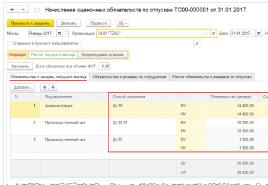Akkadian and Aramaic languages among the Assyrians. Akkadian language Akkadian alphabet
AKkadianlanguage.
To record the Akkadian language in writing, verbal-syllabic cuneiform was used, borrowed from the Sumerians and representing groups of wedge-shaped signs squeezed onto clay tablets, which were then fired.
The cuneiform system consists of:
simple and complex ideograms;
signs with phonetic reading, indicating syllables.
The same group of signs often has several ideographic and - at the same time - phonetic meanings. The rendering of syllables is ambiguous: different signs can be used for the same thing. There are no separating marks or spaces between words, as was common in all ancient writing systems. Reading is facilitated by the presence of determiners - signs indicating that a word belongs to a certain class in meaning (for example, “mātu” - country - before the names of countries, “ilu” (god) - before the names of gods).
Sumerianwriting.
Sumerian writing is verbal and syllabic in nature. It is based on pictorial signs (pictograms), which are ideograms that convey not a word, but a concept (concept), and most often not one, but a number of associatively related concepts. Initially, the number of characters in the Sumerian language reached a thousand. Gradually their number was reduced to 600. Almost half of them were used as logograms and at the same time as syllabograms, which was facilitated by the monosyllabic nature of most Sumerian words, the rest were only logograms. When read in each individual context, the ideogram sign reproduced one specific word, and the ideogram became a logogram, that is, a sign for a word with its specific sound. A pictorial sign most often expressed not one concept, but several conceptually related verbal meanings. The presence of signs expressing more than one word created polyphony. On the other hand, Sumerian had a large number of homonymous words - homophones, apparently differing only in musical tones, which were not specifically reflected in the graphics. As a result, it turns out that to convey the same sequence of consonants and vowels there can be up to a dozen different signs, differing not depending on the sound of the word, but on its semantics. In Sumerology (the most convenient Deimel system is used here), when transliterating such ‘homophones’, the following notations are accepted: du, du2, du3, du4, du5, du6, etc., in order of approximate frequency.
There were many monosyllabic words in the Sumerian language, so it turned out to be possible to use logograms that convey such words for purely phonetic transmission of words or grammatical indicators that could not be reproduced directly in the form of a pictorial ideogram sign. Thus, logograms begin to be used as syllabograms. At the end of the first half of the 3rd millennium BC. e. Determinatives appeared, denoting the category of a concept, for example, determinatives of wooden, reed, stone objects, animals, birds, fish, etc.
The rules for transliterating Sumerian texts should be noted. Each character is transliterated in lowercase Roman letters, separated from the transliteration of another character within the same word by a hyphen. Determinatives are written above the line. If the correct choice of one or another reading of a sign in a given context cannot be made, then the sign is transliterated in capital Latin letters in its most common reading. There are no doubled consonants in Sumerian, so spellings like gub-ba are purely orthographic and should be read /guba/.
Chineseletteŕ
The Chinese script has been the only generally accepted way of writing the Chinese language for several thousand years. Chinese characters are also widely used in Japanese and Korean writing (where they are called kanji and hanja). Until 1945, Chinese script was also used to write Vietnamese (Han Tu).
The age of Chinese writing is constantly being clarified. Recently discovered inscriptions on turtle shells, reminiscent of ancient Chinese characters in style, date back to the 6th millennium BC. e., which is even older than Sumerian writing.
Chinese writing is usually called hieroglyphic or ideographic. It is radically different from the alphabetical one in that each character is assigned some meaning (not just phonetic), and the number of characters is very large (tens of thousands).
According to legend, hieroglyphs were invented by Cang Jie, the court historiographer of the mythical emperor Huang Di. Before this, the Chinese used knot writing. The oldest Chinese records were made on tortoise shells and ox bones, and recorded the results of fortune telling. Such texts are called jiaguwen. The first examples of Chinese writing date back to the last period of the Shang Dynasty (the most ancient - to the 17th century BC).
Later, the technology of bronze casting arose, and inscriptions appeared on bronze vessels. These texts were called jinwen. The inscriptions on bronze vessels were previously extruded onto a clay mold, the hieroglyphs were standardized, and they began to fit into a square.
Etruscanalphabet- a set of characters characteristic of the written Etruscan language. Related to the Greek and early Latin alphabet.
The most famous monuments of Etruscan writing are tombstones and ceramics. Currently, about nine thousand inscriptions made using the Etruscan alphabet are known - found on tombstones, vases, statues, mirrors and jewelry. Fragments of the Etruscan linen book Liber Linteus were also found.
The problem with deciphering is that the Etruscans did not have a writing system, that is, they wrote both from left to right and from right to left. In addition, boustrophedon is also found: one line is written from left to right, the second line from right to left, the third from left to right, etc. The second difficulty is that the words were not always separated from each other.
Etruscan inscriptions were already incomprehensible to the Romans, who had a proverb “hetruscum non ligatur” (“Etruscan is not readable”). All later attempts to read Etruscan inscriptions on the basis of any of the known languages were unsuccessful; The prevailing point of view is that the Etruscan language is not related to the known European languages and is isolated.
Since the Etruscan language has not been deciphered, and the ordered set of characters used by the Etruscans themselves (the alphabet in the proper sense of the word) is unknown, the Etruscan alphabet is a reconstruction. This applies to both the number of letters and their shape, as well as the sound of the corresponding sounds. The basis for reading is the few Latin-Etruscan bilinguals and Etruscan recordings of proper names.
About 90 Etruscan characters are known to appear in Etruscan writing. They are reduced to 27 basic characters, the rest are considered graphic variations.
Dateś yskayapí shifts- one of the first phonetic writing systems recorded in human history. Appeared around the 13th century BC. e. and became the ancestor of most modern writing systems.
The Phoenician script is one of the first alphabetic scripts in the world, however, it was the Phoenician script that gave rise to several branches of alphabetic scripts, and, today, almost all alphabetic scripts in the world (with the exception of Japanese Kana and Korean script) have roots in the Phoenician script. Other scripts with an alphabetical structure - Old Persian cuneiform and Meroitic writing - did not take root.
Alphabeticalwriting is a writing where one character conveys one sound, in contrast to logographic and ideographic writing, where each character corresponds to a specific concept or morpheme. Syllabic writing also cannot be considered an alphabetic writing, since each character corresponds to a separate syllable, but not a sound.
language, literature worthy of itself... they used not only cuneiform, but also Akkadian tongue and the administrative system adopted in... and historical texts on Akkadian language, which were reproduced in the Amorite...
History of the states of Mesopotamia
Abstract >> Culture and artAnd the Euphrates, talked in Akkadian language. In southern Mesopotamia, the Semites... occupied almost all of Mesopotamia. Gradually Akkadian language supplanted Sumerian, and by the beginning... 6th century BC. Aramaic language became official tongue, A Akkadian language was forced out. By the 1st century BC...
Sumero Akkadian civilization
Report >> Culture and artPopular hero of the Sumerian and Akkadian literature. Unified for works... and Akkadian peoples occurred gradually, the displacement of Sumerian language Akkadian(Babylonian... Sumerian in origin. Akkadian mythological texts of the Old Babylonian...
From the dead Semitic languages A. i. lasted the longest time (approx. 3 thousand years), and it preserved the largest number of various documents. In the beginning. III millennium BC it was the spoken language of the Semitic population of the first states of Mesopotamia, where at that time non-Semitic Sumerian was used as a written language, which was spoken and written by the Sumerians who appeared in the South. Mesopotamia before the arrival of the east. Semites (Akkadians). The Sumerians took precedence in the invention of cuneiform writing (late 4th millennium BC), later. borrowed and adapted by the Akkadians for their language. For example, while maintaining the external form of the letter, many of the signs designated in Sumerian. individual words (often consisting of one syllable), in A. i. began to denote syllables. The long coexistence of the two languages on the same territory led to their significant influence on each other, but Ch. arr. Sumerian in Akkadian, which led to the loss of certain guttural sounds, lexical and syntactic borrowings. To the beginning II millennium BC A.I. almost supplanted the Sumerians. and became an official. the language of Babylonia and Assyria, as well as diplomatic and partly lit. total Dr. Near East. One of the evidence of this is the texts compiled (with rare exceptions) in A. Amarna letters, representing Egyptian diplomatic correspondence. pharaohs of the 18th dynasty (XIV century BC) with the kings of Assyria, Babylonia, Mitanni and with the rulers of city-states in the East. Mediterranean, including Canaan. All R. I millennium BC in the role of the language of international diplomacy A. I. replaced Aramaic - official. language of the Achaemenid Empire. Largely due to the wide distribution of A. i. Cuneiform writing became known to the peoples neighboring the Mesopotamian states and was adapted for Urartian, Hittite, Hurrian, Eblaitic, Elamite and other languages. In Canaan in the 2nd millennium BC. and cuneiform was used by scribes who conducted international correspondence; In the 1st millennium BC, the alphabetic date became widespread here. letter.
And I. divided into dialects: Old Akkadian. (III millennium BC), Old Babylonian and Old Assyrian. (beginning of the 2nd millennium BC), Middle Babylonian and Middle Assyrian. (mid-late 2nd millennium BC), Neo-Babylonian (X-V centuries BC), Neo-Assyrian. (X-VII centuries BC) and late Babylonian (IV century BC - 1st century AD).
And I. in the 3rd millennium BC.
The earliest evidence of A. i. represent individual proper names in Sumerian. texts from the Fara period (c. 2600 BC). Texts written entirely in Akkadian - from the reign of Sargon the Ancient and his dynasty (c. 2350-2150 BC) - are mainly dedicatory inscriptions, historical chronicles, letters, economic, legal and administrative. documentation. The writing system has not yet reached the degree of precision characteristic of later periods of development of the alphabet: there is still no special sign for the glottal plosive, doubling of consonants and extra-long vowels are not displayed. In the state of Sargon, who united all of Mesopotamia under his rule, Akkad. first used along with Sumerian. as an official written language. In the kingdom of Sumer and Akkad (3rd dynasty of Ur, 21st century BC) official. Sumerian becomes the language again, but A. I. spreads more and more outside the royal offices and by the 16th century. BC completely supplants the Sumerians.
Old Babylonian (1950-1530 BC) and Old Assyrian. (1950-1750 BC)
From the beginning II millennium BC, the division of A. is planned. into 2 main dialects - Babylonian (in South Mesopotamia) and Assyrian. (in the middle reaches of the Tigris and in the east of Asia) - associated with the emergence of new centers of statehood - Babylon and Ashur. In the offices of the Babylonian ruler Hammurabi (1792-1750 BC), a new, more precise style of writing was formed. The activities of an extensive bureaucratic apparatus, as well as the judicial reform carried out by Hammurabi, led to the emergence of many economic and legal documents, including the laws of Hammurabi - the largest monument of law of Dr. Mesopotamia. An extensive literature was created in the Old Babylonian dialect: epics, hymns, prayers. The language of these works, also called the hymno-epic dialect (the prologue and epilogue of the laws of Hammurabi are written in it), became lit for a long time. language both in Babylonia and Assyria. Most of the Old Assyrians. texts are letters and business documents, with the exception of one spell and several. royal inscriptions.
Middle Babylonian and Middle Assyrian. (1530-1000 BC)
From about the 2nd half. II millennium BC in A. I. The fall of the Babylonian corps begins and a new standard of lit. is developed. language - the standard Babylonian dialect, based on Ch. arr. Old Babylonian material with elements of the Middle Babylonian state of morphology (eg, loss of mimicry in nouns and pronouns). Standard Babylonian remained the norm lit. language until the creation of the last lit. works in A. i. Outside of lit. The Middle Babylonian standard is represented by a small number of letters and business documents. Middle Assir. the dialect is recorded in the code of the so-called. Middle Assir. laws (XIV-XIII centuries BC), letters, ritual texts and several others. royal inscriptions (Tiglat-pileser I and others). It was during this period that Akkad. became the language of diplomacy in Dr. Near East, including in Syria and Palestine.
Neo-Babylonian (1000-538 BC) and Neo-Assyrian. (1000-625 BC)
Both dialects were used primarily in letters and legal documents; New Assyrian is also represented by contracts, a certain number of litas. texts and historical inscriptions of the Assyrians (Salmaneser III, Tiglath-pileser III, Sennacherib, Ashurbanipal) and Urartian kings. During this period, Aram spreads in Mesopotamia. language, the influence of which is felt in Akkad. (borrowing a preposition and other features). Defeat of the Assyrians. kingdom by the Medes and Babylonians in 616-605. led to the loss of the A. Ya. by the Assyrians, completely supplanted by the Aram.
Late Babylonian (538 BC - 1st century AD)
presented in letters, business documents and royal inscriptions; characterized by the expansion of Aram influence. After the end of the existence of the Babylonian kingdom of A. I. continues to be used in several cities (Babylon, Uruk, etc.).
The main characteristic features of A. i.
1. The presence of 2 prefixal conjugations for the perfective and imperfective forms of the verb and a suffixal conjugation of the state predicate (stative). 2. The existence of 12 verbal varieties - the most complete set among the Semitic languages. 3. The presence of a causative verb prefix, in contrast to [ or ], in other Semitic languages, with the exception of Ugaritic. 4. Lack of article. 5. The presence of case endings for nouns, adjectives and pronouns, as in classical Arabic. language.
History of the study of A. i. and its significance for biblical studies
Until sep. XIX century cuneiform texts, including Akkadian ones, could not be deciphered. The key to their understanding was the decipherment of ancient Persians. cuneiform writing, begun in 1802 by G. F. Grotefend and continued by E. Burnouf and K. Lassen. The work of these researchers allowed G. Rawlinson in the 40s. XIX century read ancient Persian. text of the trilingual part (Old Persian, Akkadian, Elamite languages) of the Behistun inscription of Persians. King Darius I (c. 521 BC), and in the middle. 50s Through the efforts of G. Rawlinson, E. Hinks and J. Oppert, Akkadian was deciphered. part of this inscription by using comparative data from already known Semitic languages - Hebrew, Arabic, Aram. The first scientific grammar of A. I. (1889) and a dictionary (1896) were created by Friedrich Delitzsch, who in his work “Babylon and the Bible” (Babel und Bibel, 1902; Russian translation 1912) tried to show the significance of the achievements of Assyriology, the study of Babylonian-Assyrians. Literatures for interpreting the Old Testament. Archaeological excavations in Mesopotamia, begun in the 20s. XIX century, tens of thousands of cuneiform documents were introduced into scientific use, a significant part of which are texts in A. I. Their study greatly changed ideas about the world of the Old Testament and about the history of Dr. Near East. The report of the discovery by J. Smith in 1872 of an excerpt from the Epic of Gilgamesh with a narrative about the flood became a real sensation. Until the beginning XX century study of A. i. was considered, as a rule, only an auxiliary branch of biblical studies. In the 20th century, especially after the discoveries in Ras Shamra (see Ugarit) and Qumran, Assyriology began to occupy a more modest, although quite significant, place among the auxiliary historical and philological disciplines in the study of the Old Testament. This coincided with its identification as an independent field of knowledge.
The first steps in studying A. i. in Russia in con. XIX century associated with the names of V. S. Golenishchev, the author of the first Akkadian in Russia. dictionary and list of cuneiform characters (1888), M. V. Nikolsky, B. A. Turaev and P. K. Kokovtsov, who began teaching A. I. at St. Petersburg University. Translations from A. I. and V.K. Shileiko, A.P. Riftin, I.M. Dyakonov and others studied it. In the end. 90s XX century teaching A. i. and Assyriology is conducted at St. Petersburg University (Eastern Faculty) and at the Russian State University for the Humanities (History and Philology Faculty) in Moscow.
Decipherment of cuneiform texts and discovery of A. i. made it possible to clarify and clarify the meanings of many words and phraseological units of ancient Hebrew. language (see Hebrew language), which are borrowings from A. Ya.: Hebrew. Akkadian - sailor, sailor; euro Akkadian - wall; euro Akkadian-Sumerian. - stable; euro Akkadian Sumerian - castle; euro Akkadian - door; euro - translation Akkadian - translator - etc. Certain historical events described in the Old Testament and in Babylonian and Assir inscriptions. kings, found mutual confirmation, their attribution was clarified. The most important sources on the history of Canaan and others. Israel in the 3rd-2nd millennium BC are Akkadian. documents from (the laws of Eshnunna, Hammurabi, Middle Assyrian laws), Old Testament prophecies (including finds from Mari) (for this see Babylonian-Assyrian literature and the Bible).
Lit.: Soden W. von. Der hymnisch-epische Dialekt des Akkadischen // ZA. 1932. Bd. 40. S. 163-227; 1933. Bd. 41. S. 90-183; idem. Akkadisches Handwörterbuch. Wiesbaden, 1959-1981. Bd. 1-3; idem. Grundriss der Akkadischen Grammatik. R., I9953; The Assyrian Dictionary. Chicago, 1956-; Lipin L. A. Akkadian (Babylonian-Assyrian) language. L., 1957. Issue. 1: Reader with a table of signs. Vol. 2: Dictionary; Friedrich I. Deciphering forgotten scripts and languages. M., 1961; Ungnad A., Matous L. Grammatik des Akkadischen.Münch., 19644; Dyakonov I. M. Languages of ancient Western Asia. M., 1967; aka. Akkadian language // Languages of Asia and Africa. IV. Afroasiatic languages. Book 1: Semitic languages. M., 1991; Borger R. Handbuch der Keilschriftliteratur. B., 1967-1975. 3 Bde; Grande B. M. Introduction to the comparative study of Semitic languages. M., 1972, 1982; Bergstr ä sser G. Akkadian // Introduction to the Semitic Languages / Transl. P. T. Daniels. Winona Lake, 1983, pp. 25-49; Caplice R. Introduction to Akkadian.R., 19883; Huehnergard J. A Grammar of Akkadian. Atlanta, 19982; Black J., George A., Postgate N. et al. A Concise Dictionary of Akkadian. S.I., 1999.
A. K. Lyavdansky
Bas-relief from the palace of the Assyrian kings in the city of Nimrud. Scribes count the severed heads. The one who stands closest to the audience writes on papyrus in Aramaic, and the one further away writes on a clay tablet in Akkadian.
My translation of an English article. Original.
The ancient Assyrian language is called Akkadian. It was the language of the Assyrians and Babylonians, written in cuneiform. To facilitate the administrative tasks of the Assyrian Empire, Aramaic was made the second state language in 752 BC.
Imperial officials adopted a simple standard form of Aramaic for business correspondence. In the heart of the Empire, "Aramaic inscriptions" were written on cuneiform tablets. Such inscriptions contain names, dates and other information necessary for merchants. Many Assyrian tablets with Aramaic inscriptions written on them have been found. Assyrian scribes are often depicted in pairs - one writing in Akkadian on cuneiform tablets, the other in Aramaic on a sheet of parchment or papyrus (see the picture in the title of the post).
Among the lion-shaped weights found in Nineveh, some are inscribed with both Akkadian and Aramaic text, inscribed with the names of Assyrian kings who reigned during the times when these weights were used, including Shalmaneser III (858 - 824), Sargon (721 - 705), Sennacherib (704 - 681). Official Aramaic was later adopted as the standard form of literary communication between Aramaic-speaking inhabitants of various parts of the Empire. It's named Assyrian Aramaic(less often Imperial Aramaic).
According to the Old Testament, in 701, when the envoys of the Assyrian king Sennacherib appeared before the walls of Jerusalem and Ribsak addressed the commanders of King Hezekiah's army in Hebrew, they asked him to speak better Aramaic, since they understood his official language and did not want the population to hear derogatory demands about submission in Hebrew.
17 And the king of Assyria sent Tartan and Rhabsaris and Rabshakeh from Lachish to king Hezekiah with a large army to Jerusalem. And they went and came to Jerusalem; and they went and came and stood at the water supply of the upper pond, which is on the road of the whitewash field.
18 And they called the king. And Eliakim the son of Hilkiah, the ruler of the palace, and Shebna the scribe, and Joah the son of Asaph the recorder, went out to them.
19 And Rabshakeh said to them, Tell Hezekiah, Thus says the great king, the king of Assyria: What is this hope in which you trust?
20 You spoke only empty words: for war you need advice and strength. Now in whom do you trust, that you have abandoned me?
21 Behold, you think to lean on Egypt, on this bruised reed, which, if anyone leans on it, will go into his hand and pierce it. Such is Pharaoh, the king of Egypt, to all those who trust in him.
22 And if you say to me, “In the Lord our God we trust,” is it the one whose high places and altars Hezekiah abolished, and said to Judah and Jerusalem, “Before this altar alone shall you worship in Jerusalem”?
23 So enter into an alliance with my lord the king of Assyria: I will give you two thousand horses; can you get yourself riders for them?
24 How can you defeat even one leader of the least of my lord’s servants? And do you trust in Egypt for chariots and horses?
25 Moreover, did I go to this place without the will of the Lord to destroy it? The Lord said to me: “Go to this land and destroy it.”
26 And Eliakim the son of Hilkiah and Shebna and Joah said to Rabshakeh, Speak to your servants in Aramaic, for we understand, and do not speak to us in Hebrew in the hearing of the people who are on the wall.
In later centuries, Aramaic replaced Hebrew even in Israel. During their time in Babylonian captivity, the Jews adopted the square Assyrian script known as Ketav Ashuri or Assyrian text. The law required that Torah scrolls be written in Ketav Ashuri.
Over time, Aramaic became the lingua franca of Mesopotamia, gradually replacing Akkadian. Such a transition was possible due to the similarity of languages. And also because the 22 letters of the Aramaic alphabet are more convenient for a scribe than the 600 or so characters of cuneiform.
The fact that both languages still coexisted in the 4th century BC is confirmed by the Aramaic document available to researchers from Uruk, written in klipis. In Babylon, the Akkadian language fell out of use around 140 BC, remaining the property of a few priests who used it for religious purposes. However, Akkadian continued to be the language of astronomers and astrologers (which in those days was the same thing) until the time of Christ.
Most ancient languages have undergone significant transformation over time for various reasons. For example, the English language has changed a lot from what it was, for example, in the 9th century. Modern English speakers will have difficulty reading and understanding the Jesus Prayer written in Old English (see text below):
"Feder Ure bu be eart on hefonum, si bin nama gehalgod. To prepare bin rice. Gewurbe Oin willa on Eoroan swa swa on heoronum..."
Modern Assyrians use thousands of words in conversation every day that are purely Akkadian.
Syriac, another name for the language of the Christian Assyrians, may have been used as a literary language in northern Mesopotamia, but only a few written pre-Christian texts dating from the 1st century AD have survived. Syriac developed as a literary language in Edessa, where there was a large scientific school, which was the heir of the pagan educational center. Syriac was gradually adopted as the language of the Church and culture by the Aramaic-speaking Christians of the region. There are two slightly different dialects of Syriac, called Eastern and Western, respectively. It should be noted that the modern spoken Assyrian language (Eastern or Western) is older than the written language of the Church (Edessa dialect). For example, in Akkadian the word weapon keke (keke)(literally tooth, since the weapon has cutting devices), in Syriac liturgical weapon is denoted by the word zaineh (zaineh), and in modern Eastern Assyrian checke (check)- almost the same as in Akkadian.
Some differences in the pronunciation of words between ancient and modern Assyrian may exist due to the inability of translators to accurately convey the sound of cuneiform characters. Some of the cuneiform characters may have different pronunciations. It should be pointed out that although all ancient Assyrian words ended in "U", in modern East Assyrian in its basic form the words end in "A". The vowel sound “A” of the Eastern dialect is pronounced “O” in all cases in the Western dialect.
The list below contains words that come from Akkadian. Without words, declensions, tenses, adjectives, adverbs, plural and gender forms derived from them. If all these vocabulary forms were added to the list, it would contain thousands of words.
Compiled by Peter BetBasoo and William Warda using glossaries contained in the following literature:
- "State Archives of Assyria, Volume III: Court Poetry and Literary Miscellanea", by Alasdair Livingstone, Helsinki University Press.
- Samuel A.B. Mercer, "Assyrian Grammar with Chrestomathy and Glossary" Frederick Ungar Publishing, New York, 1961
- Samuel A.B. Mercer, "Assyrian Grammar" London 1921
- Orhaham's Dictionary of the stabilized and enriched Assyrian Language and English, Chicago Ill. 1943



Notes:
1. Ribsak (Rab - Shakeh) - this was such a court position of the chief cupbearer, and the person who occupied it was not necessarily involved in serving the Assyrian king at meals. Compare with steward or bedside in the Moscow state.
2. The Russian language does not convey differences, but in English Syriac- in relation to modern Assyrians, and Syrian- in relation to the Syrian Arabs, whose self-name of the country is not Syria, but Sham.
3. The same Peter Bitbazu, who successfully debunks the myths about the “Arab-Islamic civilization”:
Entries from this journal tagged “Assyria”
 Memorial Day of St. Sergius the General (Surb Sarkis Sparapet).
Memorial Day of St. Sergius the General (Surb Sarkis Sparapet).This saint is revered only in the AAC. But in his Life it is mentioned that before St. Mesrop Mashtots transferred his relics to Armenia, to the village of Ushi...
 Assyrian succession. Article by Fred Uprim.
Assyrian succession. Article by Fred Uprim.My translation of the article by Assyrian publicist Frederic Aprim (Fred Aprim) "Assyrian Continuity". Original on the Aprima website:...
 From the family of Nimrod.
From the family of Nimrod.About Nimrod in the Assyrian tradition. I wonder which other Assyrian kings and later rulers were related to the family of the biblical Nimrod? Excerpt...
 History of Assyrian-Georgian relations.
History of Assyrian-Georgian relations.Modern Georgian icon of the 13 Assyrian fathers. An excerpt from Roland Bijamov’s article “3118 years of Assyrian-Georgian…
or Assyro-Babylonian, a language of the Semitic branch of the Afroasiatic language macrofamily, spoken in Mesopotamia since at least the 3rd millennium BC. and until the beginning of our era. According to the classification of I.M. Dyakonov, it forms the north-peripheral, or north-eastern group of Semitic languages.
The first traces of the Akkadian language are found in cuneiform inscriptions in Sumerian (an ancient non-Semitic language of Mesopotamia, extinct by the beginning of the 2nd millennium BC; cuneiform was invented by the Sumerians), dating back to approximately 3000 BC. These are personal names and words borrowed by the Sumerians from the Akkadian language. With the emergence of the first Akkadian state and its subsequent expansion under King Sargon and his successors (c. 23412160 BC), in Old Akkadian the term is applied to the Akkadian language of the 3rd millennium BC. began to speak and write over a vast territory from Akkad (the region of modern Baghdad) in the south to Assyria (the region of modern Mosul) in the north. In addition, at the same time, the Old Akkadian language began to gradually spread throughout the territory of Sumer in southern Mesopotamia and through the territory of Elam, the eastern neighbor of the Akkadians. The subsequent revival of Sumerian dominance, which lasted approximately two centuries, threatened for some time to put an end to Akkadian expansion, but new invasions of Semitic peoples c. 2000 BC led to the complete displacement of the Sumerian language by Akkadian, which became official throughout Mesopotamia.
After 2000 BC the Akkadian language has two clearly distinct dialects: Babylonian, spoken in the south in Babylonia, and Assyrian (not to be confused with modern Assyrian, which belongs to another group of Semitic languages!), spoken in the north in Assyria; For each of these dialects, several historical stages of development are distinguished. The Assyrian dialect of Akkadian appears to be a direct descendant of the Old Akkadian language, while Babylonian has a number of features that cannot be traced back to Old Akkadian and which go back to other, more ancient and still poorly recognized dialects.
The Babylonian dialect had much greater cultural significance than Assyrian. Since the middle of the 2nd millennium BC. Babylonian was widely used as a kind of lingua franca throughout the Middle East and became the language of correspondence between the royal courts of the Hittites, Hurrians, Aramaes, Canaanites and Egyptians. The vast archives of Boghazkoy (Asia Minor) and Tell el-Amarna (Egypt) provide the best evidence of the widespread use of the Babylonian dialect of the Akkadian language. Even the inhabitants of Assyria, who previously used exclusively their own dialect, began to use the Babylonian dialect from the middle of the 2nd millennium, first in their historical inscriptions, and subsequently in written texts of a general nature. As a result, by the end of the Assyrian period, all Assyrian texts were written in the Babylonian dialect, with the exception of numerous letters and business documentation, where the local Assyrian dialect continued to be used. The more archaic character of the Assyrian dialect is evident when compared with Babylonian; in particular, the so-called weak consonants remain uncontracted even in Late Assyrian, whereas in the most ancient Babylonian texts they appear in a contracted form.
To record the Akkadian language in writing, verbal-syllabic cuneiform, borrowed from the Sumerians, was used. The oldest Akkadian monument dates back to the 25th century. BC, later 1st century. AD; in the last centuries of its existence, the Akkadian language, supplanted by Aramaic, was used only in a few cities of Babylonia.
see also MESOPOTAMIA, ANCIENT CIVILIZATION.
Dyakonov I.M. Languages of ancient Western Asia. M., 1967
A multi-volume dictionary of the Akkadian language, prepared by several generations of specialists, is now available online on the website of the Oriental Institute of the University of Chicago, Polit.ru reports. Akkadian, formerly called Assyro-Babylonian, is a Semitic language. It is known to us from numerous cuneiform monuments. Thanks to the conquests of the Assyrian kings, it spread widely in the Middle East. Also from the middle of the 2nd millennium BC. e. Akkadian was used in diplomatic correspondence between ancient Eastern rulers, and was used by both the Hittite kings and the pharaohs of Egypt. From the 4th century BC. e. it began to be replaced by Aramaic as the main language of communication in the region, but remained in written form for a long time.
The Chicago Akkadian Dictionary was founded in 1921 by the famous American archaeologist and historian Henry Brasted. The dictionary was originally planned to have ten volumes, but eventually the number grew to twenty-one. The first volume was published in 1956, and the last in 2011. The dictionary contains the most comprehensive collection of Akkadian vocabulary extracted from texts dating from 2500 BC. e. before 100 AD e. In total it contains about 28 thousand words. The printed edition of all volumes of the dictionary costs more than a thousand dollars, but on the project website all volumes are available in PDF format.







